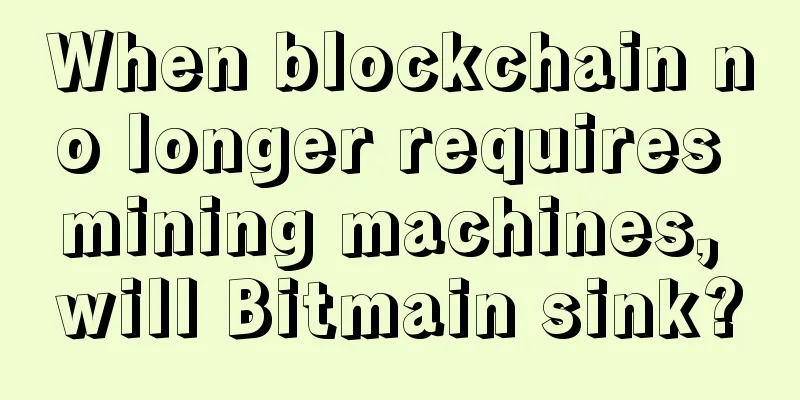When blockchain no longer requires mining machines, will Bitmain sink?

|
At the end of March this year, Bitmain launched an ASIC-based Antminer X3, which is mainly aimed at Monero (XMR) and cryptocurrencies that rely on the CryptoNight algorithm. Monero immediately issued a counter-statement that it would change the core algorithm to combat the invasion of ASIC computing power. In April, Ethereum developer Piper Merriam released an "Ethereum Improvement Protocol" coded as "958". The main "improvement" of this improvement protocol is said to be mainly aimed at the Ethereum mining machine that Bitmain is about to release. This is not the first time Bitmain has clashed with the cryptocurrency community over its control over computing power. According to ICWise, Bitmain's sales in 2017 are expected to reach a staggering 14.3 billion yuan, surpassing the domestic mobile phone chip design company Spreadtrum and ranking second in the 2017 list of China's top ten integrated circuit design companies, second only to Huawei HiSilicon. In an interview with the media, Wu Jihan, the founder of Bitmain, also mentioned that Bitmain already has more than 70% of the computing power on the Bitcoin network. This computing power monopoly also led to the fork of BTC and BCH. As the boundaries of Bitmain's mining machines continue to expand, how to deal with Bitmain's computing power monopoly has become a problem that every "distributed currency" will inevitably face. What is a computing power attack? Putting aside Bitmain, BCH, ETH and Monero, let’s first talk about what computing power is, what computing power monopoly is, what computing power attack is, and what it means for encrypted digital currency. First, let's talk about what PoW is. Most of the explanations of PoW you see elsewhere are like this: Proof of Work, through calculation, guesses a value (nonce) to solve the specified hash problem. It ensures that only a few legal proposals can appear in the system within a period of time. These small number of legal proposals will be broadcasted in the network, and the receiving users will verify and continue the calculation of the problem based on what they think is the longest chain. Therefore, there may be a fork of the chain in the system, but eventually one chain will become the longest chain. People who participate in the POW calculation need to pay a certain economic cost, such as hardware, electricity, etc. When you are not the first person to calculate the answer, these costs are consumed, which also guarantees the security of the entire blockchain. If someone wants to maliciously damage it, he needs to pay a lot of economic costs. Don’t understand? Don’t worry, we will use the most common metaphor in popular science articles about Bitcoin to translate it. First, we compare digital cryptocurrencies represented by Bitcoin to a village. In this village, everyone has a paper account book at home. The village stipulates that every time a business is done in this village, it must be announced using the loudspeaker at the entrance of the village. No matter if Zhang San gave Wang Er 1 yuan today, or Wang Er gave Li Si 2 yuan tomorrow, all the villagers listened to the radio at all times and wrote their own account books to be consistent. In this metaphor, which is the easiest way to understand what a distributed ledger is, there is actually one question that is not explained: how do you know that the broadcast you hear is real? If Wang Er buys a speaker today, can he transfer a lot of money to his account at will? There is a group of people in the radio station at the entrance of the village. Their job is to read the broadcast for each trader, and after reading each transaction information, they will also attach a code at the end. This code is not made up randomly, but the answer to a "math problem" that is uniformly stipulated by the whole village. Although this math problem is very troublesome for ordinary people to calculate, as long as the answer is obtained and the result is reversed, the equation can be established quickly to verify that this answer is a real "answer". And you can understand that this "math problem" is a multivariate equation that we have learned. It has countless solutions, so each transaction is different and you cannot forge it. The group of people who read the radio for the guests at the village radio station are miners. The process of their calculations is mining, and the machines used for calculations are... graphics cards or mining machines. In practice, we often equate miners and mining machines as computing nodes on the blockchain network, but in this article, miners refer to natural persons engaged in encrypted digital currency mining, and mining machines are computing nodes. Since the birth of Bitcoin in 2009, mining machines have gone through several stages: It can be seen that the replacement of mining machines in just a few years is comparable to the evolution of integrated circuits in the past few decades. Driven by capital, technology has developed rapidly. In addition, the deployment of mining machines is also mainly concentrated in mainland China and Europe and the United States. Thanks to China's advantages in low-voltage, low-power integrated circuit design and China's low regional electricity prices, mainland China's encrypted digital currency mining industry and mining machine industry have flourished. Is there anything wrong with this? Theoretically, there is no problem. As more and more nodes join the mining, it is equivalent to more people waiting for the calculations at the village entrance. In fact, the whole system should be more stable. But what if the machines these miners use to calculate are all from the same manufacturer? That would be a big problem. On October 25, 2017, Apple broke the news that a bug appeared in the calculator of iOS 11: when the user quickly entered 1+2+3, the result given on the screen was 24. What would happen if this happened in the world of cryptocurrency? Wrong calculations could be introduced into the entire network without anyone noticing. What’s more crucial is that if a “calculator manufacturer” monopolizes the calculator market, it can also deliberately produce such faulty calculators to change the rules of mathematics. After all, "calculation" in the field of encrypted digital currency is not as simple as 1+2+3. You can't manually verify Bitcoin with paper money. The practical significance of Bitmain’s computing power monopoly We have already learned about attacks based on 51% computing power in various articles. But the reality is that although about 78% of the world’s computing power was previously in mainland China, fortunately they were scattered in different mining pools and controlled by different people. Although all PoW-based cryptocurrencies are at risk of being attacked by 51%, the dispersion of computing power means that few people can actually launch an attack. But what if the miners themselves do not want to launch an attack, but the mining machine manufacturer launches an attack? To use the same analogy, although each miner wants to do the calculation independently, their calculators are tampered with remotely and give the same wrong answers. This may pose a great threat to digital cryptocurrencies. However, Bitmain, the manufacturer that has absolute control over mining machines, has once encountered such a problem. In April 2017, the Antbleed backdoor was exposed in Bitmain's mining machines. Although it was described as a "vulnerability" in the Chinese circle, Antbleed was more like a designed function. Anonymous personnel discovered that after an Antminer produced by Bitmain is connected to the Internet, it will regularly communicate with a domain name held by Bitmain, and send the serial number, MAC address and IP address of the miner back to Bitmain's server. If the Bitmain server gives a negative signal, the miner will stop running. Although Bitmain responded that they cannot shut down any mining machine that does not belong to them, the Bitcoin Core team proved in an experiment that this function actually has no verification and anyone can shut down the mining machine by forging DNS - but this also means that Bitmain has the ability to shut down any mining machine that has been sold. Afterwards, Bitmain fixed the "loophole", but it sparked heated discussions in the community, which laid the foundation for almost all PoW blockchain communities to be biased against Bitmain. A few months later, under the leadership of Bitmain, ViaBTC mined the first block and hard forked the Bitcoin blockchain. From then on, Bitcoin Cash BCH (Bitcoin Cash) came into being in the world. Will mining machine monopoly destroy the distributed system? Facing this problem, we should now have a clear answer. That is, the monopoly of mining machines will definitely affect the safe operation of PoW digital cryptocurrency. The question is not whether Bitmain and its founder Jihan Wu are trustworthy, but that one of the values of any blockchain system should be to operate securely without trusting any single company or individual. Even if ASIC mining machines are not monopolized by Bitmain, ASIC mining machines themselves will increase the concentration of computing power. ASICs used for mining have high requirements for ventilation, electricity, and space. They have no other use except for mining. At the same time, their powerful computing power increases the computing difficulty of the entire network. This makes it difficult for external players to download software on their computers and start mining like they did five years ago. The recent frequent hacking of centralized exchanges also proves that concentration in this unregulated market will definitely lead to insecurity. If the Bitcoin network is run by 1 million miners, no one person can shut it down. If the Bitcoin network is run by 20 large mining farms, it will be much easier to shut it down. As of the end of 2017, 78% of computing power was concentrated in mainland China, which actually made it possible for Chinese regulators to launch a fatal attack on Bitcoin. Moreover, most use cases of digital cryptocurrencies are related to "decentralization". Once centralized, these use cases will no longer exist, causing a project that may have been valuable to become a pure waste of computing power. So, what measures should we take in the face of this situation? First of all, as a project owner, maybe it’s time to abandon the pure PoW mechanism. In fact, in many projects that issue encrypted digital currencies, especially in asset securitization projects, PoS, which is similar to the concept of stocks in the real world, is more reasonable than PoW. In the media that do not understand blockchain, we often hear such words as "Bitcoin wastes a lot of computing power and is worthless", which makes sense to a certain extent. It is difficult for the PoW-based blockchain to bind the value of the project itself to the issued digital cryptocurrency - because the real value behind the price of the currency does not come from the project, but from the cost of maintaining computing power. The hybrid model of PoW+PoS is more like the future. In the hybrid model, both coin holders and miners can participate in the major decisions of the community. If a decision is widely recognized, the blockchain will be soft-forked to the latest state without excessive intervention from developers, and there will be almost no private resistance from miners or mining machines. Secondly, as a retail miner, if you are still mining a pure PoW currency, you should unconditionally support the fork activities initiated by the community to resist ASIC mining machines, even if this will cause your mining machines to fail. This may sound a bit contradictory, but from a long-term perspective, it is better to promote community reforms to gain more benefits than to exhaust all resources in a currency controlled by a computing power monopoly. Because, in many past conflicts between computing power and the community, the final result was that the computing power owner would forcibly retain the old algorithm and hard fork the blockchain. Just like ETH and ETC, the classic Ethereum (ETC), which belongs to the main computing power, has lost the support of developers and has become a lifeless air coin that is impossible to develop applications. As a retail investor, you should be cautious when trading non-mainstream digital currencies (except Bitcoin) supported by Bitmain mining machines to avoid falling into a blockchain whose computing power is completely controlled by Bitmain. Finally, if you were Bitmain, what would you do? Bitmain's goal is to become Intel, AMD, and Nvidia, to make greater contributions to the entire computer industry, and to become a great company, rather than just focusing on the immediate benefits of mining. Wall Street financiers have long seen through the violence caused by Nvidia graphics card mining. The company's stock price has risen and fallen in line with the price of Bitcoin, and can even be said to be affected by the market of digital currencies. Citron, a well-known short-selling institution, has recently been bearish on Nvidia, believing that the company has put too much energy into providing services for digital currency miners instead of focusing on serious businesses such as artificial intelligence, games and driverless cars. The mission of chip manufacturers is to provide more powerful chips to drive smarter services and ultimately contribute to the real world, rather than becoming a monopoly tycoon in the virtual world. When people no longer enter the door of the virtual world, all that will be left is a wasteland without people. In an interview with US media last year, Wu Jihan revealed that he would conduct an IPO with a market value of billions of dollars. As a company that is about to go public, Bitmain not only has to be responsible to investors, but also has to accept investors' questions about the sustainability of its business. "What if your mining machine encounters a fork after listing?" This question, which will only be asked after the listing, has already appeared: the price of the forked coin XMO after the Monero team split is currently $7.5, while the real Monero coin XMR is currently priced at $194. The forked coin has been completely abandoned by the Monero community. Before Bitmain became a name spurned by the entire blockchain community, it could have relied on the huge capital accumulated in recent years to transform into an artificial intelligence chip company as planned, rather than continuing to develop a variety of digital currency mining machines to squeeze out the last drop of oil before the ecosystem collapses. |
<<: Are you still building a mining farm? Now it is popular to use mobile mining farms for mining!
>>: Antminer Series Parameters Summary
Recommend
What kind of man should you not marry?
What does the most unmarriageable man look like? ...
What does a HK financial license require to operate virtual assets?
Recently, the Hong Kong Treasury Department passe...
E-commerce giant acquires Bitnet and creates blockchain lab to develop blockchain applications in financial technology and e-commerce
E-commerce giant Rakuten has acquired the IP asse...
What is the fate of a woman with broad shoulders?
What is the fate of a woman with broad shoulders?...
What does a bachelor look like?
What does a bachelor look like? 1. The tip of the...
What are the facial features of people who insist on their own way and refuse to communicate?
In fact, everything requires more communication. ...
What does the four white eyes represent?
In terms of physiognomy, four white eyes are not ...
Is the fortune of people with square faces good? Analysis of the fortune of people with square faces
People with square face and earlobes If a person ...
What is the Brothers Palace? A detailed explanation of the Brothers Palace in the twelve palaces of physiognomy
The Palace of Brothers among the twelve palaces o...
Bitcoin's monetary concept reshapes human trust awareness
The Economist pointed out in an article that Bitc...
The personality of people with sword-shaped eyebrows and their strategies in business
Sword-shaped eyebrows are eyebrows with the tail ...
Is the fate of a woman with a mole on her lower lip good? Mole physiognomy analysis
Everyone knows about moles, and moles can appear ...
Do people with thin faces and no flesh on their cheeks often speak with sharp words?
I believe that most of the time, it is very easy ...
What is CBDC and how can it become a disruptor of traditional finance?
Central bank digital currencies, or CBDCs, are a ...
Almond-shaped eyes
Eyes are the windows to the soul and represent a ...









